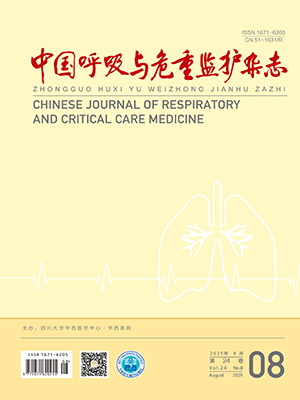| 1. |
Rabe KF, Hurd S, Anzueto A, et al. Global strategy for the diagnosis, management, and prevention of chronic obstructive pulmonary disease: GOLD executive summary. Am J Respir Crit Care Med, 2007, 176(6): 532-555.
|
| 2. |
Wedzicha JA, Seemungal TA. COPD exacerbations: defining their cause and prevention. Lancet, 2007, 370(9589): 786-796.
|
| 3. |
Afessa B, Morales IJ, Scanlon PD, et al. Prognostic factors, clinical course, and hospital outcome of patients with chronic obstructive pulmonary disease admitted to an intensive care unit for acute respiratory failure. Crit Care Med, 2002, 30(7): 1610-1615.
|
| 4. |
Kallet RH. Noninvasive ventilation in acute care: controversies and emerging concepts. Respir Care, 2009, 54(2): 259-263.
|
| 5. |
Brochard L, Mancebo J, Wysocki M, et al. Noninvasive ventilation for acute exacerbations of chronic obstructive pulmonary disease. N Engl J Med, 1995, 333(13): 817-822.
|
| 6. |
Boles JM, Bion J, Connors A, et al. Weaning from mechanical ventilation. Eur Respir J, 2007, 29(5): 1033-1056.
|
| 7. |
Crimi C, Noto A, Princi P, et al. A European survey of noninvasive ventilation practices. Eur Respir J, 2010, 36(2): 362-369.
|
| 8. |
Guarracino F, Cabrini L, Ferro B, et al. Noninvasive ventilation practice in cardiac surgery patients: insights from a European survey. J Cardiothorac Vasc Anesth, 2013, 27(5): e63-e65.
|
| 9. |
Thille AW, Richard JC, Brochard L. The decision to extubate in the intensive care unit. Am J Respir Crit Care Med, 2013, 187(12): 1294-1302.
|
| 10. |
Ozsancak Ugurlu A, Sidhom SS, Khodabandeh A, et al. Use and outcomes of noninvasive positive pressure ventilation in acute care hospitals in Massachusetts. Chest, 2014, 145(5): 964-971.
|
| 11. |
Perkins GD, Mistry D, Gates S, et al. Effect of protocolized weaning with early extubation to noninvasive ventilation vs invasive weaning on time to liberation from mechanical ventilation among patients with respiratory failure: The Breathe Randomized Clinical Trial. JAMA, 2018, 320(18): 1881-1888.
|
| 12. |
Hilbert G, Clouzeau B, Nam Bui H, et al. Sedation during non-invasive ventilation. Minerva Anestesiol, 2012, 78(7): 842-846.
|
| 13. |
Constantin JM, Schneider E, Cayot-Constantin S, et al. Remifentanil-based sedation to treat noninvasive ventilation failure: a preliminary study. Intensive Care Med, 2007, 33(1): 82-87.
|
| 14. |
Senoglu N, Oksuz H, Dogan Z, et al. Sedation during noninvasive mechanical ventilation with dexmedetomidine or midazolam: a randomized, double-blind, prospective study. Curr Ther Res Clin Exp, 2010, 71(3): 141-153.
|
| 15. |
Muriel A, Peñuelas O, Frutos-Vivar F, et al. Impact of sedation and analgesia during noninvasive positive pressure ventilation on outcome: a marginal structural model causal analysis. Intensive Care Med, 2015, 41(9): 1586-1600.
|
| 16. |
Rocco M, Conti G, Alessandri E, et al. Rescue treatment for noninvasive ventilation failure due to interface intolerance with remifentanil analgosedation: a pilot study. Intensive Care Med, 2010, 36(12): 2060-2065.
|
| 17. |
Nantsupawat N, Nantsupawat T, Limsuwat C, et al. Factors associated with reintubation in patients with chronic obstructive pulmonary disease. Qual Manag Health Care, 2015, 24(4): 200-206.
|
| 18. |
Standards for the diagnosis and care of patients with chronic obstructive pulmonary disease. American Thoracic Society. Am J Respir Crit Care Med, 1995, 152(5 Pt 2): S77-S121.
|
| 19. |
Roche Campo F, Drouot X, Thille AW, et al. Poor sleep quality is associated with late noninvasive ventilation failure in patients with acute hypercapnic respiratory failure. Crit Care Med, 2010, 38(2): 477-485.
|
| 20. |
O'Mahony R, Murthy L, Akunne A, et al; Guideline Development Group. Synopsis of the National Institute for Health and Clinical Excellence guideline for prevention of delirium. Ann Intern Med, 2011, 154(11): 746-751.
|
| 21. |
Reston JT, Schoelles KM. In-facility delirium prevention programs as a patient safety strategy: a systematic review. Ann Intern Med, 2013, 158(5 Pt 2): 375-380.
|
| 22. |
Chan KY, Cheng LSL, Mak IWC, et al. Delirium is a strong predictor of mortality in patients receiving non-invasive positive pressure ventilation. Lung, 2016, 195(1): 115-125.
|
| 23. |
Villar J, Slutsky AS. Effects of induced hypothermia in patients with septic adult respiratory distress syndrome. Resuscitation, 1993, 26(2): 183-192.
|
| 24. |
Clouzeau B, Bui HN, Vargas F, et al. Target-controlled infusion of propofol for sedation in patients with non-invasive ventilation failure due to low tolerance: a preliminary study. Intensive Care Med, 2010, 36(10): 1675-1680.
|
| 25. |
Salam A, Tilluckdharry L, Amoateng-Adjepong Y, et al. Neurologic status, cough, secretions and extubation outcomes. Intensive Care Med, 2004, 30(7): 1334-1339.
|
| 26. |
Organized jointly by the American Thoracic Society, the European Respiratory Society, the European Society of Intensive Care Medicine, et al. International Consensus Conferences in Intensive Care Medicine: noninvasive positive pressure ventilation in acute respiratory failure. Am J Respir Crit Care Med, 2001, 163(1): 283-291.
|
| 27. |
Pallin M, Naughton MT. Noninvasive ventilation in acute asthma. J Crit Care, 2014, 29(4): 586-593.
|
| 28. |
Chen L, Xu M, Li GY, et al. Incidence, risk factors and consequences of emergence agitation in adult patients after elective craniotomy for brain tumor: a prospective cohort study. PLoS One, 2014, 9(12): e114239.
|
| 29. |
Epstein SK, Ciubotaru RL. Independent effects of etiology of failure and time to reintubation on outcome for patients failing extubation. Am J Respir Crit Care Med, 1998, 158(2): 489-493.
|




